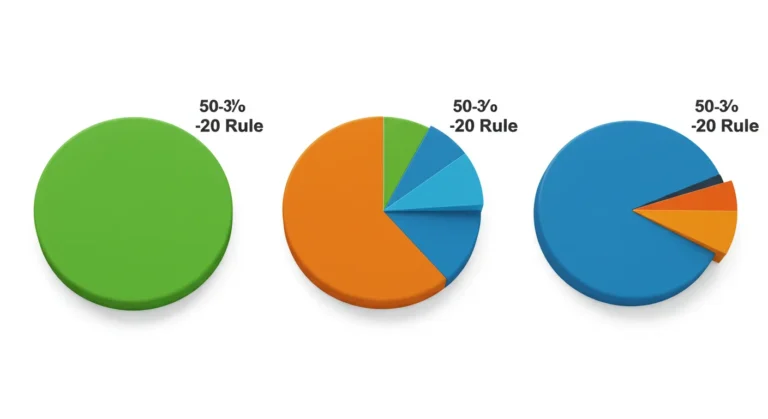What is the 50 30 20 rule Dave Ramsey? This is a budgeting framework made popular by financial guru Dave Ramsey, designed to help individuals and families manage their finances efficiently. By allocating your income into three simple categories—needs, wants, and savings—you can create a balanced budget that promotes financial stability and growth. But why should you care about the 50 30 20 rule? If you’ve ever felt overwhelmed by money management or frustrated by how quickly your paychecks disappear, this rule offers clear and actionable guidance to regain control. In a world where financial literacy is increasingly essential, understanding this budgeting method can open doors to a more confident financial future.
Let’s consider the essence of this rule: it’s straightforward and uncomplicated. The beauty lies in its simplicity, allowing it to be adaptable to your life circumstances without being restrictive. Think of it as your financial GPS, guiding you toward where you want to go while helping you avoid detours that lead to debt or financial struggle. If you’re someone who’s just starting your financial journey or looking to overhaul your budgeting strategy, the 50 30 20 rule could be the compass you need.
Each percentage of your income represents a different segment of your financial life—50% for needs, 30% for wants, and 20% for savings and debt repayment. This allocation not only ensures you meet your essential requirements but also gives you room to enjoy life while preparing for future financial security. As we dive deeper into each category, you might start seeing your financial landscape in a whole new light.
So, are you ready to explore how to implement the 50 30 20 rule effectively? Let’s break down each segment, discuss some practical tips, and share anecdotes that might resonate with your own financial experiences. From budgeting novices to seasoned planners, understanding and applying this rule can enhance your financial well-being.
Understanding the 50% Needs Allocation
The first pillar of the 50 30 20 rule is the needs allocation, which takes up half of your total income. Needs encompass any expenses that are essential for your day-to-day existence—think housing, utilities, groceries, healthcare, and transportation. It’s critical to get this portion right, as these are non-negotiable expenses that you must cover to maintain your standard of living.
Defining Necessities vs. Luxuries
One common challenge here is distinguishing between needs and wants. For example, a smartphone is a valuable tool for modern living, but is that top-tier model truly a necessity? Perhaps a more budget-friendly option would suffice. Here’s a quick list to help clarify:
- Needs: Rent/Mortgage, utilities, insurance, basic groceries, transportation costs.
- Wants: Dining out, subscription services, premium phone plans.
Practical Steps to Control Needs Spending
Here’s where it gets real. Start by tracking your necessary expenses for one month. This practice helps illuminate areas where you might be overspending. After analyzing your spending habits, prioritize cutting costs without sacrificing your quality of life—a great way to start is by shopping sales or using coupons.
Diving into the 30% Wants Allocation
The next segment of your budget, 30%, is for wants. This includes non-essential items and services that enhance your lifestyle but aren’t critical for survival. Think of it as your discretionary spending. From that brand-new pair of shoes to that weekend getaway, this pocket of money allows for flexibility and enjoyment, crucial for maintaining a balanced life.
Identifying Your Financial Joys
To effectively manage this category, begin by identifying what truly brings you joy. Do you relish fine dining, or is it more about movie nights at home? Understanding your priorities can help you allocate your wants spending more wisely. Consider creating a ‘fun fund’ where you set aside a specific amount each month, making it easier to splurge guilt-free.
Strategies for Want Spending
Adopting a “30-day rule” can also be beneficial. Before making a purchase in the wants category, wait 30 days to evaluate whether you still desire the item. This technique curbs impulse buys and often leads to more intentional spending.
The Importance of the 20% Savings and Debt Repayment
The final segment of the 50 30 20 rule—20% of your income—is dedicated to savings and debt repayment. This portion is your safety net and your investment in your future. By allocating this amount toward emergency savings, retirement accounts, or paying down debts, you are actively working towards financial freedom.
Building an Emergency Fund
Ideally, your emergency fund should cover three to six months of living expenses. This fund protects you from unexpected financial shocks like car repairs or medical bills. If you’re just starting, aim for a small savings goal, such as $500 or $1,000, which can provide peace of mind during unforeseen circumstances.
Debt Repayment Plans
If you’re in debt, consider focusing a portion of this 20% on high-interest debts first. Strategies like the snowball method—paying off smaller debts first for psychological momentum—can help you stay motivated while you work toward larger financial goals.
Real-Life Application of the 50 30 20 Rule
Now that we’ve covered the theoretical aspects of the 50 30 20 rule, let’s bring in a relatable scenario. Meet Sarah, a young professional earning $3,000 a month. By applying this rule, she allocates:
- Needs (50%): $1,500 (rent, groceries, bills)
- Wants (30%): $900 (entertainment, dining out, travel)
- Savings/Debt (20%): $600 (emergency fund, student loans)
By adhering to this structured plan, Sarah learns to manage her spending more mindfully, leave room for fun, and prioritize her future. It allows her to live within her means without compromising on the things she enjoys.
Implementing the 50 30 20 Rule Successfully
To make the 50 30 20 rule work for you, consistent practice and periodic reviews of your budget are crucial. You might realize that your percentages need adjusting as life circumstances change—such as a new job, a family addition, or changes in financial goals.
Leveraging Technology for Budgeting
Utilizing budgeting apps can make tracking your expenses easier. Look for tools that categorize your spending automatically and provide insights into your habits over time. Apps like YNAB (You Need A Budget) and Mint are popular choices that help simplify this process.
Encouraging Accountability
Finding an accountability partner—perhaps a friend or family member—can keep you motivated and prevent financial slippage. Regularly discussing your budgeting progress can foster a supportive environment to achieve your financial goals together.
By integrating these insights, strategies, and practical applications of the 50 30 20 rule into your life, you have taken significant steps toward financial empowerment. It’s a journey filled with learning opportunities, and I assure you, you’re not alone on this path. Embrace the journey, make adjustments as needed, and watch as you cultivate a healthier relationship with your finances.

Useful links
Conclusion
In wrapping up our exploration of Dave Ramsey’s 50/30/20 rule, it’s crucial to appreciate how this simple yet effective budgeting strategy can transform our approach to personal finance. By categorizing our income into needs, wants, and savings, we can take control of our financial destiny. Imagine standing at a fork in the road: one path leads to financial stress and uncertainty, while the other guides us toward stability and growth. With the 50/30/20 rule, we can confidently choose the latter.
Implementing this rule encourages us to assess our priorities. Are we spending too much on unnecessary items? Does our lifestyle reflect our financial goals? By answering these questions, we can find balance and clarity in our financial journey. It’s not just about crunching numbers; it’s about aligning our spending habits with what truly matters to us, whether that’s enjoying life today or securing a comfortable future.
So, if you haven’t already, consider giving the 50/30/20 rule a shot. It’s a liberating framework that can simplify budgeting and promote healthier financial habits. I invite you to grab your wallet, take a closer look at your expenses, and start making mindful choices. After all, financial freedom is an empowering journey we all deserve.
Frequently Asked Questions
What exactly is the 50 30 20 rule?
The 50 30 20 rule is a budgeting guideline that suggests dividing your after-tax income into three categories: 50% for needs, 30% for wants, and 20% for savings or debt repayment. This structure ensures you cover your essentials, enjoy a comfortable lifestyle, and prioritize financial health. By adhering to this rule, you can streamline your spending and focus on what truly matters, promoting a balanced relationship with your finances.
How do I determine what falls under needs, wants, and savings?
Needs are non-negotiable expenses essential for living, including rent, utilities, groceries, and healthcare. Wants are discretionary expenses that enhance your quality of life, like dining out, entertainment, and luxury items. Lastly, savings encompass contributions to an emergency fund, retirement accounts, or paying down debt. By clearly categorizing your expenses, you can allocate your income more effectively and maintain a healthy financial balance.
Is the 50 30 20 rule flexible?
Absolutely! While the 50/30/20 rule provides a solid framework, it can be tailored to fit individual circumstances. If your situation calls for a higher savings rate, adjust the percentages accordingly. For instance, if you’re preparing for a major life event, you might allocate 40% of your income to savings temporarily. The key lies in personalization, ensuring the rule aligns with your financial goals and current lifestyle.
Can I still enjoy life while following the 50 30 20 rule?
Definitely! The beauty of the 50/30/20 rule is that it encourages you to prioritize enjoyment without compromising your financial health. By allocating 30% of your budget to wants, you can indulge in experiences and luxuries while maintaining a responsible approach to spending. The goal is to find balance—enjoying today while preparing for tomorrow.
What if my expenses don’t fit neatly into these categories?
It’s completely normal for expenses to overlap or not fit perfectly into the 50/30/20 categories. If certain expenses don’t align, consider creating subcategories for better organization. For instance, transportation can be a need for commuting but also a want if it includes ride-sharing for leisure outings. The key is flexibility and clear categorization, allowing you to visualize your spending patterns more effectively.
How can I track my expenses effectively while following this rule?
Tracking your expenses can be done through budgeting apps, spreadsheets, or even good old-fashioned pen and paper. Choose a method that resonates with you and ensures regular updates. For best results, review your budget weekly or monthly and adjust as necessary. Spending a little time on this can yield immense benefits, guiding you toward better financial choices.
What are some common mistakes to avoid when using the 50 30 20 rule?
A common pitfall is neglecting to truly analyze needs versus wants. It’s easy to classify certain expenses incorrectly, leading to skewed budgets. Additionally, failing to account for irregular expenses can derail your budgeting efforts. Always account for annual subscriptions or seasonal costs upfront to maintain accuracy. Lastly, avoid rigidly sticking to the rule—adapt and adjust based on your personal financial situation for the best outcomes.


